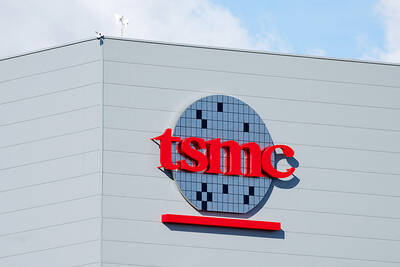GlobalWafers Co (環球晶圓) is building out manufacturing overseas in anticipation of rising tariffs on chip materials, underscoring growing expectations that tit-for-tat trade measures would disrupt the semiconductor supply chain in coming years.
The world’s third-largest provider of silicon wafers is expanding its factories in six of the nine countries where it operates, including two factories in the US, one in Italy and one in Denmark.
“I believe that not only in the US, but also some other countries, there will be some special tariff” in the industry, GlobalWafers chairwoman and chief executive officer Doris Hsu (徐秀蘭) told Bloomberg Television.

Photo: Ritchie B. Tongo, EPA-EFE
Potential tariffs can be avoided by shifting to local production, Hsu said.
Governments around the world increasingly view semiconductor technology through the lens of national security following chip shortages during and after the COVID-19 pandemic that crippled many industries, including vehicle manufacturing. Rising geopolitical tensions have also raised the stakes.
Geopolitics is now driving the way companies do business, Hsu said.
A turning point for the company was a bid by GlobalWafers to buy German silicon wafer rival Siltronic AG for US$5 billion, which fell apart in 2022 after failing to win regulatory approval.
Prior to the Siltronic bid, more than 80 percent of GlobalWafers’s growth came from mergers and acquisitions, Hsu said.
“We changed our policy because we found that it’s more and more difficult to do any cross-border M&A,” she said, referring to mergers and acquisitions.
“That was why starting from 2022, we have expansion in six countries at the same time,” she added.
GlobalWafers, which supplies the shiny round plates from which Taiwan Semiconductor Manufacturing Co (台積電) and Samsung Electronics Co etch circuits and slice into chips, is able to tap into some of the subsidies that countries are doling out to secure more production at home.
This year it secured a grant of as much as 103 million euros (US$114 million) from the European Commission and Italian government to build a 12-inch wafer plant in Novara, Italy. It also won US$400 million from the US CHIPS Act for plant expansions in Texas and Missouri that would support the creation of 2,500 jobs in construction and manufacturing.
GlobalWafers is emerging from a years-long slump in consumer electronics and vehicle sales.
The company, which has lost roughly half its market value since its peak in 2021, is hoping to ride a gradual market recovery, Hsu said.
GlobalWafers competes with Japan’s Sumco Corp and Shin-Etsu Chemical Co.

Taiwan Semiconductor Manufacturing Co (TSMC, 台積電) secured a record 70.2 percent share of the global foundry business in the second quarter, up from 67.6 percent the previous quarter, and continued widening its lead over second-placed Samsung Electronics Co, TrendForce Corp (集邦科技) said on Monday. TSMC posted US$30.24 billion in sales in the April-to-June period, up 18.5 percent from the previous quarter, driven by major smartphone customers entering their ramp-up cycle and robust demand for artificial intelligence chips, laptops and PCs, which boosted wafer shipments and average selling prices, TrendForce said in a report. Samsung’s sales also grew in the second quarter, up

LIMITED IMPACT: Investor confidence was likely sustained by its relatively small exposure to the Chinese market, as only less advanced chips are made in Nanjing Taiwan Semiconductor Manufacturing Co (TSMC, 台積電) saw its stock price close steady yesterday in a sign that the loss of the validated end user (VEU) status for its Nanjing, China, fab should have a mild impact on the world’s biggest contract chipmaker financially and technologically. Media reports about the waiver loss sent TSMC down 1.29 percent during the early trading session yesterday, but the stock soon regained strength and ended at NT$1,160, unchanged from Tuesday. Investors’ confidence in TSMC was likely built on its relatively small exposure to the Chinese market, as Chinese customers contributed about 9 percent to TSMC’s revenue last

With this year’s Semicon Taiwan trade show set to kick off on Wednesday, market attention has turned to the mass production of advanced packaging technologies and capacity expansion in Taiwan and the US. With traditional scaling reaching physical limits, heterogeneous integration and packaging technologies have emerged as key solutions. Surging demand for artificial intelligence (AI), high-performance computing (HPC) and high-bandwidth memory (HBM) chips has put technologies such as chip-on-wafer-on-substrate (CoWoS), integrated fan-out (InFO), system on integrated chips (SoIC), 3D IC and fan-out panel-level packaging (FOPLP) at the center of semiconductor innovation, making them a major focus at this year’s trade show, according

DEBUT: The trade show is to feature 17 national pavilions, a new high for the event, including from Canada, Costa Rica, Lithuania, Sweden and Vietnam for the first time The Semicon Taiwan trade show, which opens on Wednesday, is expected to see a new high in the number of exhibitors and visitors from around the world, said its organizer, SEMI, which has described the annual event as the “Olympics of the semiconductor industry.” SEMI, which represents companies in the electronics manufacturing and design supply chain, and touts the annual exhibition as the most influential semiconductor trade show in the world, said more than 1,200 enterprises from 56 countries are to showcase their innovations across more than 4,100 booths, and that the event could attract 100,000 visitors. This year’s event features 17